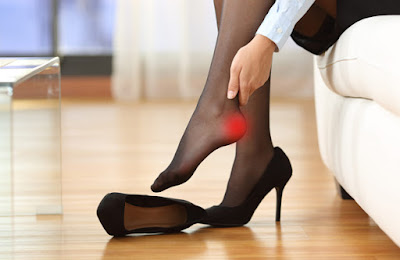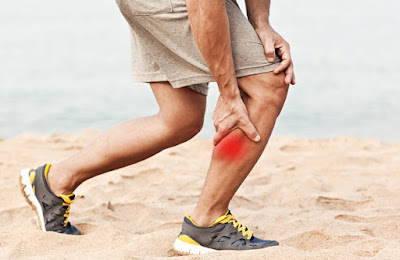Heel pain is frustrating. At times, you can feel the
tenderness with every single step you take. It can be severely limiting to your
daily activities at home and work, and to life in general. It’s no surprise
then, that when heel pain develops, our patients are after the same thing – to
get rid of it as fast as possible.
This is absolutely our goal for you too, and we put
everything in place to help make this happen and address both your symptoms and
the causes of your heel pain too. Whether you have plantar fasciitis, a
tendinopathy, a bursitis, a capsulitis or any problem that’s causing you
heel/foot pain, we’ve got the treatment solutions to have your injury fixed,
and reduce the chance of your injury recurring again in the future.
Unfortunately, there ARE things you may be doing that are
worsening your injury and resulting in a longer healing and recovery time than
either of us would like for you. We thought we’d highlight the top FOUR common
mistakes so you can stay on track to your best recovery.
1. DON’T TAKE THE
PAIN OR SYMPTOMS SERIOUSLY EARLY ON
It is a common tendency these days, especially in the early
stages of injury, to brush off any niggles or tenderness in the thought that it
will just go away on its own. It’s not until the pain becomes severe, or has
persisted for over a month, that it begins to be taken seriously and with
greater care.
Unfortunately, by the time the pain is severe or long-standing,
the injury will be much worse than when you first felt it. This means a much
longer recovery, much to your (and our) frustration. An example of this is a mild
case of plantar fasciitis that progresses to a plantar fascial tear when proper
care isn’t taken.
We know it’s easy to think that when a tenderness or mild
pain comes on during running or an activity, that it’ll go away just as quickly
as it came on. The truth is that for pain to occur, that muscle or tissue will
have been overloaded and pushed past its limits for some time now, until it has
been too much and damage has occurred. As it’s left untreated, the injury
worsens and becomes more serious (and painful).
The lesson: Listen to your body when pain, tenderness or
niggles occur, and manage it effectively so that it doesn’t worsen.
2. KEEP DOING THE
ACTIVITIES THAT CAUSED OR CONTRIBUTED TO THE INJURY
This links into the last point in that when you don’t take
an injury seriously, you don’t take it easy, rest properly, or stop doing the
activities that led to your injury in the first place.
Because most non-traumatic, overuse injuries are linked to
certain activities that are done regularly and repetitively, failing to rest
and continuing with regular activities will cause further damage and leave you
with an even longer recovery time. This may be a sporting activity, or just a
high-load activity like always choosing the stairs at work.
We understand that for many people, accepting that they are
truly ‘injured’ when they haven’t been to the hospital or have a cast on is
difficult, and so they try to keep life and daily activities as normal as
possible. The truth is that you DO have a serious injury and we haven’t put a
cast on for both your quality of life and because we’ll gradually introduce
movement and range of motion exercises into your treatment plan, which won’t
work with a cast.
The lesson: If your podiatrist tells you to stop doing
certain activities, stop them. If you want to recover optimally and in a timely
manner, that is. Your daily activities will change but only until you recover.
The time it takes for recovery will depend on what you do, and don’t do, in
this time.
3. CONSTANTLY TAKE
ANTI-INFLAMMATORIES AND PAINKILLERS FOR A PROLONGED TIME
While anti-inflammatories and painkillers have a role to
play in helping to manage painful symptoms in the initial stages of recovery,
they cannot be continually relied upon throughout the weeks of recovery (unless
indicated by your GP). Doing so, may actually have a detrimental effect. There
are two reasons for this:
While decreasing inflammation helps settle painful symptoms,
inflammation is an essential part of the healing and repair process. When an
area is inflamed, blood is directed to the area and with it come oxygen and
nutrients necessary for tissue repair and healing.
If you’re constantly taking painkillers, you may ‘feel’
better than you are, and start using your foot and heel normally as you cannot
feel the pain so much. This can actually cause further damage and result in a
longer recovery time. Pain on certain movements is our body’s way of telling us
not to do that movement because it involves the damaged tissues/structures.
The lesson: Painkillers and anti-inflammatories definitely
play a role in helping manage painful symptoms in the initial stages of injury,
but if you’re taking them longer than 3-5 days following your injury, check
with your GP.
4. DON’T DO YOUR
STRETCHES AND PHYSICAL THERAPY REGULARLY
During your treatment at the appropriate times through your
recovery, we’ll prescribe a series of stretching/strengthening exercises for
you to complete daily. This is something that some patients can struggle with,
and unfortunately, this is much to their detriment.
These exercises are given to you because sufficient repair
has occurred that you can safely handle the exercises, and because your
tissues, joints or muscles will have weakened and lost some flexibility/range
of motion as you have been recovering. This makes you vulnerable to re-injury
(and susceptible to other injuries) if we don’t get you back to your healthy
and strong pre-injury state. This is what these exercises are designed to do
and doing them as prescribed will mean the best short and long-term recovery.
The lesson: Make time for your exercises, even if that means
setting a reminder or alarm on your phone. If you’re struggling to complete the
exercises due to pain or other limitations, talk to your Podiatrist as they will have alternative versions for you to do
instead.
The good news is that you’ve already done the best first
step and sought treatment quickly. Often patients wait weeks, if not months,
before seeking professional care in the hopes that the pain will just go away
on its own. Unfortunately, even if the pain does resolve, the improper healing
of the tissues leave the area weakened and vulnerable to future re-injury.
Our expert team at Sole Motion Podiatry specialise
in helping you recover from lower limb injuries and get back to doing the
things you love. Whether you have a new or long-standing injury, we’d love to
help you feel your best. To book in, give our expert team a call on
1300-FX-FEET

